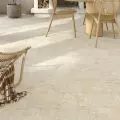When if not now? The idea of "arboreal architecture" by Magdalena Abakanowicz is returning to wider circulation at the perfect time . Thirty years ago, the Polish artist proposed green skyscrapers for Paris. The concept, which has only gained strength over time, is recalled by curator Anna Borowiec in an important exhibition at Poznan's National Museum.
The year is 1991, and the era of starchitects flooding the world with their iconic designs has just arrived, parametric design is coming into play, and technology is increasingly encroaching on the precincts of architecture, which sometimes shrinks - as Rem Koolhaas will show in Venice in 2014 - to the soffit in installation-saturated buildings. At the same moment, at the dawn of the turbo decade of the 1990s, Magdalena Abakanowicz, the internationally acclaimed 60-year-old sculptor and artist who revolutionized artistic textiles, is proposing to Paris dozens of skyscrapers shaped like giant trees. "Arboreal" (from the Latin "arbor" - tree) are both the forms of the buildings and the walls overgrown with vegetation.
"Each building is a vertical garden," the artist described her concept. It is just recalled by the exhibition "We are fibrous structures" at the National Museum in Poznań - a cross-sectional exhibition of Abakanowicz's work. It also presents a quarter-century of the artist's activity at the Poznan School of Fine Arts - today's University of Arts. A few months ago, the university established Abakanowicz as its patron, which at the same time was a pretext for opening the exhibition.
across the habits
Drawings, sketches, a kind of conventional mock-up and the author's description of "arboreal architecture" occupy one of the halls of the Poznan museum, between an extensive presentation of the artist's famous "abakanami" and figural works from her later period. "Abakans" - spatial forms woven from various types of fibers, Abakanowicz paved the way to international fame. Thanks to the Polish artist, fabric freed itself from walls and planes advancing from the decorative category to a full-fledged field of art. On the other hand, the artist brought the figural representations of headless bodies that make up spatial compositions out of museum halls into the open air. She only had to replace sisal, canvas and resins with metal. These realizations are present not only in U.S. cities, but also in Poznan, where a group of 112 walking bodies called "Unrecognized" stands in the Citadel park . Several figures from this series have also been set up by the Bałtyk office building in the city center.
The 1991 trees-towers confirm the openness, creativity and sensitivity of the artist, who boldly transgressed accepted patterns and ways of thinking. This unconventionality is also confirmed by the part of the exhibition documenting the activities of the Tapestry Studio (now the Studio of Artistic Tapestry) of the Poznań University, which Abakanowicz ran from 1965 to 1990, attracting young scholarship recipients from all over the world to Poznań.
Unlike Abakanovich's abacanas and sculptures, however, "arboreal architecture" remained only a concept. Ageometric residential skyscrapers-trees reaching 80 meters in height-were to be located on an extension of Paris' Grande Axe, an axis leading from the Champs Elysees to the office district of La Défense. Some 60 organic buildings were envisioned along the extension of the Grande Axe behind the Grande Arche (Grand Arch), completed in 1989. The buildings were intended to be energy self-sufficient: powered by wind turbines and solar cells. Today it sounds more than up-to-date; back then it was a bold transgression of current standards.
ripening into trees
Abakanovich's concept won in an international competition, to which, in addition to nearly a hundred architects, the Paris authorities also invited 22 world-renowned artists. The scarcity of finances and, arguably, the technical difficulties of translating the idea into reality meant that "arboreal architecture" disappeared from sight and failed to ignite the popular imagination. After the presentation of the concept in the world's galleries, Poles were able to get acquainted with the concept in 1994 in Warsaw's Zachęta Gallery. But, first of all, they had completely different problems on their minds then, and secondly, Abakanowicz's concept could be associated with the utopian and never-realized visions of architects from the 1960s.
The time of transformation and capitalism on steroids dominating not only in Poland was eminently not conducive to such fantasies. Thus, the imagination of the young generation of architects was ignited by organic but concrete lines from Zaha Hadid, rather than the organic coexistence of nature and architecture from a Polish woman, who, moreover, was not an architect. It is worth mentioning here that in creating her concept for Paris she was supported by forces from the field of architecture.
In order to develop the technical side of this concept, I invited Halina Starewicz - a New York architect - to work with me. Based on the latest technologies and construction possibilities, we checked the credibility of the realization of my intention. A well-known architectural firm from New York, Emery Roth &Sons Ltd. made the controlling computer drawings," Abakanowicz explained.
It was only in the following decades that what Abakanovich proposed in 1991 began to materialize. The famous Bosco Verticale of Milan by Stefano Boeri and his later projects of this type are partly the realization of the Polish artist's ideas, although - in the case of green skyscrapers - it is impossible today to escape questions about the carbon footprint of such achievements, as well as about their long lifespan not requiring high maintenance and upkeep expenses.
Nevertheless, as Abakanovich wrote, "the idea of transforming urban areas contaminated with pollution, dehumanized, into residential areas amid vertical greenery" is still very appealing. Slowly, by trial-and-error and reduction of undesirable side effects, we are maturing to make "arboreal architecture" much more feasible.
Jakub GŁAZ
Magdalena Abakanowicz "We are fibrous structures".
National Museum in Poznań
curator: Anna Borowiec
exhibition open until 24.10.2021.



















































